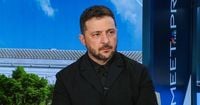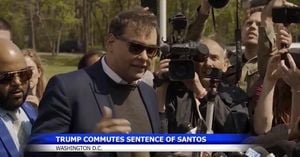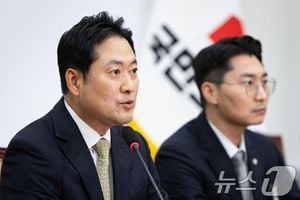Ukrainian President Volodymyr Zelenskyy left Washington last week with a mixture of hope and frustration, as the possibility of acquiring long-range U.S. Tomahawk missiles—seen as a potential game-changer in Ukraine’s war with Russia—remained tantalizingly out of reach. Following a high-stakes meeting with U.S. President Donald Trump on October 19, 2025, Zelenskyy said he was encouraged by Trump’s refusal to reject the missile request outright, but acknowledged that a firm commitment was still elusive. The diplomatic tightrope walk continues, with Russia voicing fierce opposition and the specter of renewed negotiations looming over Eastern Europe.
According to NBC News, Zelenskyy described Trump’s stance on the missile transfer as intentionally ambiguous. “It’s good that President Trump didn’t say ‘no,’ but for today, didn’t say ‘yes,’” Zelenskyy remarked in an interview with the network. He added, “I count on the continuation of this dialogue.” For Ukraine, the stakes could hardly be higher. The Tomahawk cruise missile, with its ability to strike targets deep inside enemy territory, represents a significant leap in Kyiv’s arsenal—one that could shift the balance on the battlefield and send a powerful signal to Moscow.
But if Ukraine’s optimism is rising, so too are Russian anxieties. Moscow has repeatedly warned that supplying Tomahawk missiles to Ukraine would mark a “qualitatively new stage of escalation,” threatening to destroy already fraught U.S.-Russia relations. As Zelenskyy put it, “I think that Putin is afraid that the United States will deliver us Tomahawks.” He went further, telling NBC News that the Russian president is “really afraid that we will use them.”
The missile request was just one element of a broader conversation in Washington. Zelenskyy and Trump also discussed Ukraine’s urgent need for air defense systems, as well as the prospects for peace negotiations with Russia. The timing could not be more critical. In recent weeks, Russia has intensified its attacks on Ukraine’s energy infrastructure, using drones and missiles to plunge cities into darkness and threaten an “energy disaster this winter by attacking us,” as Zelenskyy described it. Meanwhile, Ukraine has launched its own campaign against Russia’s energy supply, aiming to inflict economic pain on the Kremlin and disrupt its war machine.
Despite the destruction wrought by Russia’s airstrikes, Zelenskyy struck a defiant tone. “We are not losing this war, and Putin is not winning,” he insisted, attributing the uptick in Russian attacks to “a weak position” on the battlefield. “That’s why he really escalates airstrikes,” he explained. The war, now in its third year, has left Russia in control of nearly 44,600 square miles—or 19%—of Ukrainian territory, according to open-source battlefield maps cited by NBC News. Most of this land lies in the east and southeast, forming a stubborn front line that has resisted both Ukrainian counteroffensives and Russian advances.
For Zelenskyy, the diplomatic path forward remains fraught with uncertainty. Trump, fresh from a phone call with Putin, announced plans for a second round of in-person talks with the Russian leader in Budapest, Hungary—a move that could reshape the contours of the conflict. Zelenskyy, for his part, has made clear that Ukraine’s voice must be central in any peace process. “How can there be some deals without us about us?” he asked, underscoring his skepticism about Moscow’s willingness to negotiate in good faith. He called Putin a “terrorist,” yet reiterated his readiness to meet face to face if it would help secure a “just and lasting peace.”
Trump’s own approach has oscillated between tough talk and calls for compromise. Following his meeting with Zelenskyy, Trump posted on social media that Ukraine and Russia “should stop where they are,” urging both sides to “stop the killing, and make a DEAL.” The former president’s message—echoing his campaign rhetoric—suggests a desire to freeze the conflict along current lines, an outcome that would leave Russia in possession of significant Ukrainian territory. Zelenskyy, however, drew a clear red line. Asked if he would be willing to negotiate or cede territory to end the war, he replied, “If we want to stop this war and to go to peace negotiations urgently and in diplomatic way, we need to stay where we stay, not to give something additional to Putin.” He insisted that peace talks must occur “not under missiles, not under drones.”
The prospect of a Trump-mediated peace deal remains uncertain. The last attempt to bring Zelenskyy and Putin together fizzled after initial optimism, with the Kremlin rebuffing U.S. efforts. This time, the stakes are higher, and the obstacles more daunting. Zelenskyy told NBC News he had informed Trump, “I’m ready,” should the opportunity for direct talks in Budapest arise. Yet he remains deeply skeptical of Putin’s intentions, questioning whether the Russian leader is truly prepared for meaningful negotiations.
As the diplomatic wheels turn, Ukraine continues to press for enhanced security guarantees from Washington and supports congressional measures targeting Russia’s energy exports. These efforts are part of a broader strategy to tighten the economic noose around the Kremlin, even as Ukrainian cities brace for further attacks on their power grids and civilian infrastructure.
Throughout his U.S. visit, Zelenskyy’s message was one of resilience and determination. He repeatedly urged Trump and other Western leaders to increase pressure on Moscow, drawing a pointed comparison between Putin and Hamas. “Putin is something similar but more strong than Hamas,” he said, arguing that the war in Ukraine is larger in scale and demands a stronger international response. He praised Trump’s role in securing a ceasefire in Gaza, but insisted that “more pressure” is needed when dealing with Russia’s far larger and better-equipped military.
Yet for all the urgency, the path ahead remains clouded by uncertainty. The Tomahawk missile question—so central to Zelenskyy’s hopes—hangs in the balance, with Trump’s answer still a diplomatic “maybe.” The prospect of a breakthrough at a Budapest summit is tantalizing, but the risks of escalation are real. Russia has made clear that any significant increase in U.S. military support for Ukraine will be met with fierce resistance, both on the battlefield and in the diplomatic arena.
As winter approaches and the fighting grinds on, Ukraine’s future hangs on a knife’s edge. Zelenskyy’s appeal for continued dialogue, increased support, and a seat at the negotiating table reflects both the gravity of the moment and the enduring resilience of a nation determined not to yield. Whether the coming months will bring peace or further escalation remains to be seen, but one thing is clear: the world is watching, and the stakes could hardly be higher.




